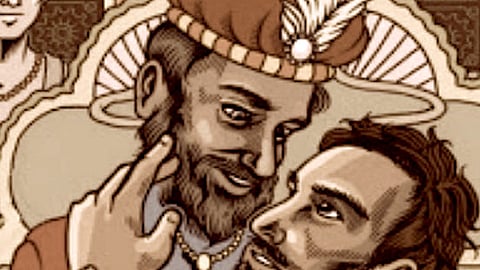- Commentary
- History Vignettes
- Notes on Culture
- Dispatches
- Podcasts
- Indian LanguagesIndian Languages
- Support

The second phase of Muslim conquest, which begins with the invasion of the Ghaznavids, is more or less characterised by the same features. The stubborn and prolonged resistance offered by the Hindu Shahi rulers Jaipal, Anandapal and Trilochanpal, the successful opposition of the Chandella ruler, and the heroic martyrdom of the defenders of Somnath and even of petty chiefs like Biji Rai and Kulachandar form so many bright spots in that dark episode of Indian history. We must remember that Sultan Mahmud was an exceptionally able general wielding the resources of a vast dominion, and was a terror even to the hardy Turks of Central Asia. His repeated successes in India do not necessarily imply that the Indians were deficient in military qualities. This is also proved by the fact that according to the Muslim chroniclers, in several campaigns the chances of victory were on the side of the Hindus till an accident or miracle saved the force of Islam. But the best evidence in this respect is furnished by the fact that Mahmud and other Ghaznavid rulers appointed Hindu generals, and recruited soldiers from India who were sent to fight in distant parts of the empire.
Another striking feature is the display of Indian unity in the face of a national danger. On at least two memorable occasions, the Hindu rulers, in large numbers from far and near, gathered under the banners of Jaipal and Anandpal to fight the common enemy of their country and religion. The campaigns of Jaipal deserve notice for more reasons than one. He was the first, but alas, also the last, Indian ruler to realise the gravity of the situation caused by the establishment of a strong Muslim power on the borderland of India. He, therefore, took the offensive and marched towards Ghazni to nip the danger in the bud. But fate was against him, and he failed on account of a sudden snow-storm. He, again for the first time, regarding the Muslim menace as a national danger organised a united front to fight it out. He failed again, but his name should go down to posterity as a great patriot, a national hero and a wise, far-seeing statesman.
He died as he lived, and put an end to his own life after his repeated attempts to resist the Muslim proved unavailing. The Indian rulers who responded to the call of Jaipal also deserve special credit. For, the enemy was still in far-off Afghanistan, beyond the Sindhu river, and none of them was in immediate danger from the Muslims. The despatch of army from the interior of India to the distant inhospitable region of Ghazni to fight an unknown foe, shows not only courage and statesmanship but also a deep sense of national unity and regard for a common religious faith.
The second confederacy under Anandapal was equally indicative of strong national sentiments. A patriotic fervour swept the whole of Hindustan. A Muslim chronicler records that
Such wide-spread national enthusiasm to save the common religion and motherland is almost unique in the annals of Indian History.
But the defeat of this confederacy—again due to the accidental disappearance of the leader and consequent lack of discipline—seems to have altogether destroyed the morale of the Indians. Instead of improving the machinery of a common organised resistance, so laboriously built up, the very idea and spirit of a united national opposition seem to have vanished altogether. This is all the more surprising because it was after the defeat of the second confederacy that the invasions of Sultan Mahmud spread far and wide, threatening even remote parts of India with all the horrors of a fanatic war.
The chief features of these invasions were massacre of men, molestation of women, desecration of temples and images, and wholesale plunder. All these were carried on, on an unprecedented scale—to the delight of the Islamic world and the glory of Islam (!)—and described in great glee by contemporary Muslim chroniclers with revolting details of what would be judged today by any standard as barbarous and inhuman conduct. It is difficult to conceive of anything more calculated to excite the individual feeling or national sentiment of a Hindu, and yet the record of the events that followed—originating from the enemies alone—does not show that the Hindus as a body were deeply moved or spurred to any heroic action.
But men were not wanting who could take a long view of things.
Thus, the king of Thaneshwar, threatened by an invasion of Sultan Mahmud, wrote to the other Indian kings with a view to organising a confederacy:
But Thaneshwar itself was submerged before any confederacy could be brought into being, and similar efforts, if any, in future came to nothing.
An explanation of this may be found in the character and ideals of the Indian leaders. We may take, for example, the case of Anandapal, son of Jaipal, both of whom fought strenuously against the rulers of Ghazni and organised confederacies of Indian kings against them.
Yet when the confederacy failed, Anandapal concluded a separate treaty with Sultan Mahmud, on condition of not only paying an annual tribute, but also helping him with 2000 soldiers. Within two years, when Mahmud marched against Thaneshwar, he refused Anandapal’s suggestion to save that city on payment of an annual tribute, saying
In spite of this open declaration of the Sultan’s motive, Anandapal not only sent to his aid the promised contingent of 2000 men, but also ordered his merchants and shopkeepers to look after the needs of the commissariat of the Muslim army.
To be continued
The Dharma Dispatch is now available on Telegram! For original and insightful narratives on Indian Culture and History, subscribe to us on Telegram.
